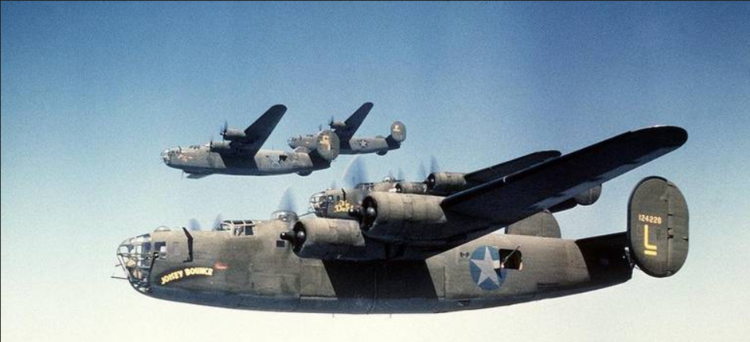


By Steve Sailer
10/18/2012
The 1972 Democratic Presidential candidate is gravely ill at age 90. From a reader review of popular military historian Stephen Ambrose’s book The Wild Blue:
This book has two central characters and is mostly a story about their shared experiences. The first subject is 2nd Lt. George McGovern, who in 1944 was just a typical US Army Air Force pilot; nothing here hints at the man, who, nearly 30 years later, would run for US president. The second is a machine, the B-24 Liberator, and one plane in particular — McGovern’s "Dakota Queen", which he piloted on 35 bombing missions over Germany from his base in Cerignola, Italy, as part of the 741st Squadron, 455th Bomb Group. …
35 bombing missions (30 as pilot) over occupied Europe was a lot. The brass tried to set the number required so that an airman had better than a 50% chance of surviving. But not a whole lot better.
The Liberator comes by it’s neglected treatment in history, and it’s earned reputation as an ugly duckling quite fairly, as the following description of conditions in the plane attests. "Steering the four-engined airplane was difficult and exhausting, as there was no power except the pilot’s muscles. It had no windshield wipers, so the pilot had to stick his head out the side window to see during a rain … there was no heat, despite temperatures that at 20,000 feet and higher got as low as 40 or 50 degrees below zero … the seats were not padded, could not be reclined, and were cramped into so small a space that a man had almost no chance to stretch and none whatsoever to relax. Absolutely nothing was done to make it comfortable for the pilot, co-pilot, or the other eight men in the crew … " Yet, as with all ugly ducklings, it had it’s day and earned it’s admirers. There were more B-24’s built than any other US airplane and Ambrose says "it would be an exaggeration to say that the B-24 won the war for the Allies. But don’t ask how they could have won the war without it."
The greater emphasis of the book is on McGovern and his crew’s experiences and it’s in the telling of these stories where Ambrose’s skills always shine; allowing the personal recollections of the participants to make the events come alive for us the readers. We follow the crew from induction through training to their arrival in Italy in 1944. There was danger from the outset. The book reveals that in basic and advanced flight training over 3,500 men lost their lives, 824 in 1943 alone; survival was an issue even before entering combat.
The number of non-combat (training and transport) aerial deaths in WWII was staggering by today’s standards.
McGovern and his crew experienced their fair share of adventures on missions. On one flight an engine quit, then another was hit by flak; on two engines he was losing altitude rapidly but McGovern managed to nurse the bomber down for an emergency landing on an airstrip less than half the length the B-24 normally required. For this feat McGovern earned the Distinguished Flying Cross. By highlighting McGovern’s experiences are we to believe that the book is portraying him as exceptional? Not at all. The reality is that when he arrived in Italy in 1944, McGovern was a 21 year old pilot. His co-pilot and navigator were the same age and half his crew were teenagers. What Ambrose sees as extraordinary is that these stories of survival, skill, courage, fortitude, bravery, and duty, are all, each and every single one, the exploits of very young men — even boys. Indeed he says "in the twenty-first century, adults would hardly give such youngsters the key to the family car, but in the first half of the 1940’s the adults sent them out to play a critical role in saving the world."
McGovern was not, by nature, a physically fearless man, so 35 missions was quite a psychological challenge for him to overcome.
I’m reminded of Frank Capra’s account of a publicity tour he made with Colonel Jimmy Stewart in 1946 to promote It’s a Wonderful Life. They had hired a private plane and pilot to get them to a Texas city in time for a parade in their honor, but the flight encountered, at various points, electrical storms, high winds, fog, dust storm, night, running low on fuel, mechanical problems, and losing track of where the airport might be. Capra, who knew nothing about flying, found the experience worrisome, but Stewart, who had commanded at least 20 bomber missions over Germany and knew every single thing that could kill an airman, was utterly terrified.